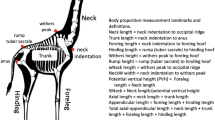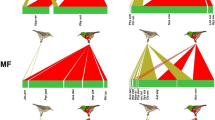Abstract
For a variety of technical and conceptual reasons, biologists have come to use several different methods to quantify the colors of animals. However, the relative abilities of these different color-scoring procedures to capture variation in the actual color-generating mechanisms—pigment or structural composition of the integument—have never been tested systematically. Here, we examined which commonly employed color metrics predict carotenoid content of ornaments in three avian species (house finch Carpodacus mexicanus, mallard duck Anas platyrhynchos, and zebra finch Taeniopygia guttata). We used spectrophotometry to measure reflectance spectra from beak and feather tissue, calculated numerous color metrics (e.g., hue, chroma, brightness, principal components, and tetrahedral color space position) from these spectra, and determined carotenoid content at the site of color measurement with high-performance liquid chromatography. We found that several principal component, tristimulus, and avian visual model metrics significantly correlated with carotenoid content of house finch feathers and duck beaks. Carotenoid content of mallard beaks was most closely correlated with brightness and saturation metrics, whereas in house finch feathers, carotenoid concentration was best captured by hue and saturation metrics. According to tristimulus scores and visual models, we found that the ultraviolet portion of the spectrum was not an essential predictor of variation in carotenoid content. Also, visual model chromatic contrasts generally were not significant predictors of carotenoid content, although some achromatic contrasts and tetrahedral color space vector parameters were. Our results indicate that numerous methods, especially tristimulus scores, are suitable for capturing pigment-based color variation in two carotenoid-containing ornaments, and we discuss the merits and shortcomings of these different approaches. In contrast, there were no significant relationships between any color metrics and the carotenoid content of zebra finch beaks, suggesting that other color-generating mechanisms besides carotenoids may contribute to color variability in this species.



Similar content being viewed by others
Abbreviations
- B:
-
Brightness
- H:
-
Hue
- HPLC:
-
High-performance liquid chromatography
- LWS:
-
Long wavelength sensitive
- MWS:
-
Medium wavelength sensitive
- PC:
-
Principal component
- PCA:
-
Principal components analysis
- S:
-
Saturation
- SWS:
-
Short wavelength sensitive
- UV:
-
Ultraviolet
- UV-Vis:
-
Ultraviolet and human-visible
- UVS:
-
Ultraviolet sensitive
- VS:
-
Violet sensitive
- θ:
-
Theta in visual model; relative stimulation of SWS, MWS, and LWS photoreceptors
- φ:
-
Psi in visual model: stimulation of the UV/V sensitive photoreceptors
- r :
-
R in visual model: chromaticity or spectral purity
References
Andersson S, Prager M (2006) Quantifying colors. In: Hill GE, McGraw KJ (eds) Bird coloration, vol I, Mechanisms and measurements. Harvard University Press, Boston, pp 41–89
Armenta JK, Dunn PO, Whittingham LA (2008) Quantifying avian sexual dichromatism: a comparison of methods. J Exp Biol 211:2423–2430
Avilés JM, Perez-Contreras T, Navarro C, Soler JJ (2008) Dark nests and conspicuousness in color patterns of nestlings of altricial birds. Am Nat 171:327–338
Bleiweiss R (2005) Variation in ultraviolet reflectance by carotenoid-bearing feathers of tanagers (Thraupini: Emberizinae: Passeriformes). Biol J Linn Soc 84:243–257
Bowmaker JK, Heath LA, Wilkie SE, Hunt DM (1997) Visual pigments and oil droplets from six classes of photoreceptor in the retinas of birds. Vis Res 37:2183–2194
Bowmaker JK, Hunt DM (1999) Molecular biology of photoreceptor spectral sensitivities. In: Archer SN, Djamgoz MBA, Loew ER, Partridge JC, Vallerga S (eds) Adaptive Mechanisms in the Ecology of Vision. Kluwer Academic Publishers, London, pp 439–462
Bright A, Waas JR, King CM, Cuming PD (2004) Bill colour and correlates of male quality in blackbirds: an analysis using canonical ordination. Behav Proc 65:123–132
Butler MW, McGraw KJ (2009) Indoor housing during development affects moult, carotenoid circulation, and beak colouration of mallard ducks (Anas platyrhynchos). Avian Biol Res 2:203–211
Cohen AA, McGraw KJ, Wiersma P, Williams JB, Robinson WD, Robinson TR, Brawn JD, Ricklefs RE (2008) Interspecific associations between circulating antioxidant levels and life-history variation in birds. Am Nat 172:178–193
Cuthill IC, Bennett ATD, Partridge JC, Maier EJ (1999) Plumage reflectance and the objective assessment of avian sexual dichromatism. Am Nat 160:183–200
Das D, Wilkie SE, Hunt DM, Bowmaker JK (1999) Visual pigments and oil droplets in the retina of a passerine bird, the canary Serinus canaria: microspectrophotometry and opsin sequences. Vis Res 39:2801–2815
Delhey K, Peters A (2008) Quantifying variability of avian colours: are signalling traits more variable? PLoS ONE 3:e1689
Eaton MD (2005) Human vision fails to distinguish widespread sexual dichromatism among sexually “monochromatic” birds. Proc Natl Acad Sci USA 102:10942–10946
Endler JA, Mielke PW (2005) Comparing entire colour patterns as birds see them. Biol J Linn Soc 86:405–431
Forstmeier W, Schielzeth H, Schneider M, Kempenaers B (2007) Development of polymorphic microsatellite markers for the zebra finch (Taeniopygia guttata). Molec Ecol Notes 7:1026–1028
Gomez D, Théry M (2007) Simultaneous crypsis and conspicuousness in color patterns: comparative analysis of a neotropical rainforest bird community. Am Nat 169:42–61
Grill CP, Rush VN (2000) Analysing spectral data: comparison and application of two techniques. Biol J Linn Soc 69:121–138
Grimm CP, Arnold PY (1995) Reading and understanding multivariate statistics. Volume 1. American Psychological Association, Washington DC
Hart N, Hunt D (2007) Avian visual pigments: characteristics, spectral tuning, and evolution. Am Nat 169:S7–S26
Håstad O, Victorsson J, Ödeen A (2005) Differences in color vision make passerines less conspicuous in the eyes of their predators. Proc Natl Acad Sci USA 102:6391–6394
Hill GE (1998) An easy, inexpensive means to quantify plumage coloration. J Field Ornithol 69:353–363
Hill GE (2002) A red bird in a brown bag: the function and evolution of colorful plumage in the House Finch. Oxford University Press, New York
Inouye CY, Hill GE, Stradi RD, Montgomerie R (2001) Carotenoid pigments in male house finch plumage in relation to age, subspecies, and ornamental coloration. Auk 118:900–915
Jane SD, Bowmaker JK (1988) Tetrachromatic colour vision in the duck (Anas platyrhynchos L.): microspectrophotometry of visual pigments and oil droplets. J Comp Physiol A 162:225–235
Lessels CM, Boag PT (1987) Unrepeatable repeatabilities: a common mistake. Auk 104:116–121
Li Q, Gao KQ, Vinther J, Shawkey MD, Clarke JA, D’Alba L, Meng Q, Briggs DEG, Prum RO (2010) Plumage color patterns of an extinct dinosaur. Science 327:1369–1372
Lind O, Kelber A (2009) Avian colour vision: effects of variation in receptor sensitivity and noise data on model predictions as compared to behavioural results. Vis Res 49:1939–1947
Loyau A, Gomez D, Moureau B, Thery M, Hart NS, Jalme MS, Bennett ATD, Sorci G (2007) Iridescent structurally based coloration of eyespots correlates with mating success in the peacock. Behav Ecol 18:1123–1131
Mahler B, Kempenaers B (2002) Objective assessment of sexual plumage dichromatism in the Picui dove. Condor 104:248–254
Maney DL, Davis AK, Goode CT, Reid A, Showalter C (2008) Carotenoid-based plumage coloration predicts leukocyte parameters during the breeding season in northern cardinals (Cardinalis cardinalis). Ethol 114:369–380
Mays HL Jr, McGraw KJ, Ritchison G, Cooper S, Rush V, Parker RS (2004) Sexual dichromatism in the yellow-breasted chat Icteria virens: spectrophotometric analysis and biochemical basis. J Avian Biol 35:125–134
McGraw KJ (2005) Interspecific variation in dietary carotenoid assimilation in birds: links to phylogeny and color ornamentation. Comp Biochem Physiol B 142:245–250
McGraw KJ (2006) The mechanics of carotenoid coloration in birds. In: Hill GE, McGraw KJ (eds) Bird coloration, vol I, mechanisms and measurements. Harvard University Press, Boston, pp 177–242
McGraw KJ, Toomey MB (2010) Carotenoid accumulation in the tissues of zebra finches: predictors of integumentary pigmentation and implications for carotenoid allocation strategies. Phys Biochem Zool 83:97–109
McGraw KJ, Adkins-Regan E, Parker RS (2002) Anhydrolutein in the zebra finch: a new, metabolically derived carotenoid in birds. Comp Biochem Physiol B 132:811–818
McGraw KJ, Safran RJ, Wakamatsu K (2005) How feather colour reflects its melanin content. Funct Ecol 19:816–821
McGraw KJ, Nolan PM, Crino OL (2006) Carotenoid accumulation strategies for becoming a colourful House Finch: analyses of plasma and liver pigments in wild moulting birds. Funct Ecol 20:678–688
McGraw KJ, Tourville EA, Butler MW (2008) A quantitative comparison of the commonly used methods for extracting carotenoids from avian plasma. Behav Ecol Sociobiol 62:1991–2002
Montgomerie R (2006) Analyzing Colors. In: Hill GE, McGraw KJ (eds) Bird coloration, vol I, Mechanisms and measurements. Harvard University Press, Boston, pp 90–147
Montgomerie R (2008) CLR, version 1.05. Queen’s University, Kingston, Canada. Available at: http://post.queensu.ca/~mont/color/analyze.html. Accessed 18 September 2009
Mougeot F, Martínez-Padilla J, Pérez-Rodríguez L, Bortolotti GR (2007) Carotenoid-based colouration and ultraviolet reflectance of the sexual ornaments of grouse. Behav Ecol Sociobiol 61:741–751
Ödeen A, Håstad O (2003) Complex distribution of avian color vision systems revealed by sequencing the SWS1 opsin from total DNA. Molec Biol Evol 20:855–861
Omland KE (1996) Female mallard mating preferences for multiple male ornaments. I. Natural Variation. Behav Ecol Sociobiol 39:353–360
Parker TH, Stansberry BM, Becker CD, Gipson PS (2003) Do melanin- or carotenoid-pigmented plumage ornaments signal condition and predict pairing success in the Kentucky warbler? Condor 105:663–671
Peters A, Denk AG, Delhey K, Kempenaers B (2004a) Carotenoid-based bill colour as an indicator of immunocompetence and sperm performance in male mallards. J Evol Biol 17:1111–1120
Peters A, Delhey K, Denk AG, Kempenaers B (2004b) Trade-offs between immune investment and sexual signaling in male mallards. Am Nat 164:51–59
Quesada J, Senar JC (2006) Comparing plumage colour measurements obtained directly from live birds and from collected feathers: the case of the great tit Parus major. J Avian Biol 37:609–616
Reudink MW, Studds CE, Marra PP, Kyser TK, Ratcliffe LM (2009) Plumage brightness predicts non-breeding season territory quality in a long-distance migratory songbird, the American redstart Setophaga ruticilla. J Avian Biol 40:34–41
Saino N, Møller AP (1996) Sexual ornamentation and immunocompetence in the barn swallow. Behav Ecol 7:227–232
Saks L, McGraw KJ, Hõrak P (2003) How feather colour reflects its carotenoid content. Funct Ecol 17:555–561
Shawkey MD, Hill GE, McGraw KJ, Hood WR, Huggins K (2006) An experimental test of the contributions and condition dependence of microstructure and carotenoids in yellow plumage coloration. Proc Roy Soc Lond B 273:2985–2991
Solís E, Avilés JM, De La Cruz C, Valencia J, Sorci G (2008) Winter male plumage coloration correlates with breeding status in a cooperative breeding species. Behav Ecol 19:391–397
Stoddard MC, Prum RO (2008) Evolution of avian plumage color in a tetrahedral color space: a phylogenetic analysis of new world buntings. Am Nat 171:755–776
Toomey MB, McGraw KJ (2009) Seasonal, sexual, and quality related variation in retinal carotenoid accumulation in the house finch (Carpodacus mexicanus). Funct Ecol 23:321–329
Toral GM, Figuerola J, Negro JJ (2008) Multiple ways to become red: pigment identification in red feathers using spectrometry. Comp Biochem Physiol B 150:147–152
Uy JAC, Endler JA (2004) Modification of the visual background increases the conspicuousness of golden-collared manakin displays. Behav Ecol 15:1003–1010
Vorobyev M, Osorio D (1998) Receptor noise as a determinant of colour thresholds. Proc Roy Soc Lond B 265:351–358
Vorobyev M, Osorio D, Bennett ATD, Marshall NJ, Cuthill IC (1998) Tetrachromacy, oil droplets and bird plumage colours. J Comp Physiol A 183:621–633
Wyszecki G, Stiles WS (1982) Color Science: concepts and methods, quantitative data and formulae. Wiley, New York, p 950
Zar JH (1999) Biostatistical Analysis, 4th edn. Prentice-Hall, Upper Saddle River, NJ
Zuk M, Johnson K, Thornhill R, Ligon JD (1990) Parasites and male ornaments in free-ranging and captive red jungle fowl. Behav 114:232–248
Zuk M, Decruyenaere JG (1994) Measuring individual variation in colour: a comparison of two techniques. Biol J Linn Soc 53:165–173
Acknowledgments
We would like to thank E. Tourville, A. Bascuñán, and V. Peng with laboratory and animal assistance, and several anonymous reviewers for comments that greatly improved the manuscript. Funding was provided to KJM by the National Science Foundation (IOS-0746364, IOS-0910357, IOS-0923694, and IOS-0925633).
Author information
Authors and Affiliations
Corresponding author
Additional information
Communicated by E. Fernandez-Juricic
Rights and permissions
About this article
Cite this article
Butler, M.W., Toomey, M.B. & McGraw, K.J. How many color metrics do we need? Evaluating how different color-scoring procedures explain carotenoid pigment content in avian bare-part and plumage ornaments. Behav Ecol Sociobiol 65, 401–413 (2011). https://doi.org/10.1007/s00265-010-1074-1
Received:
Revised:
Accepted:
Published:
Issue Date:
DOI: https://doi.org/10.1007/s00265-010-1074-1




